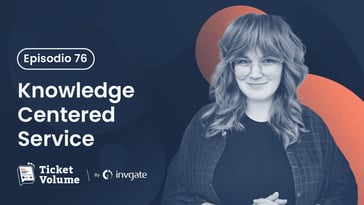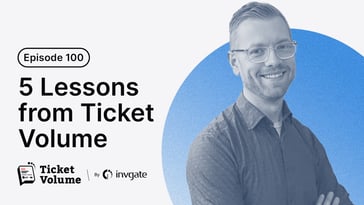As organizations grow and evolve, so does the need for a more holistic approach to Service Management. That's where value stream mapping comes in - it provides a framework for understanding and optimizing the flow of value across the entire organization.
In a previous episode, we talked to Daniel Breston about viewing it as a leadership tool. But this time around we needed to discuss value stream mapping best practices. On the 56th Episode of Ticket Volume, our IT podcast, Waseem Ahmed explained it all begins with a strong service design and continual improvement throughout the entire service lifecycle. This means keeping a close eye on performance metrics, identifying areas to optimize, and implementing positive changes to the flow of value.
Waseem's impressive resume speaks for itself. With a background in system and service experiences across different roles and companies, including American Airlines and Citi, he has a wealth of knowledge and expertise in IT Service Management (ITSM). He currently serves as the director of IT Service Management at BECU, a not-for-profit financial cooperative, where he continues to drive innovation and excellence in service delivery.
Make sure to tune in to the entire episode featuring Ahmed, as he guides you to define clear service boundaries and identify the key inputs and outputs to improve your value. And remember, you can sign up for our monthly live recordings and directly ask any questions during the session.

Value stream mapping best practices
While value streams differ for process and IT services, Ahmed emphasized the relevance of value stream mapping in gaining insights into service delivery processes, eliminating waste, and improving overall efficiency and customer satisfaction, which are important in lean principles.
|
|
"I think they're (value streams) becoming more popular now because a lot of factors are involved. One of them has to be the increase in visibility of corporate organizations, their productivity, and how they work. That's one factor. Another factor is that we're becoming more complex, and we need more visibility on things that are going on. We need more value from those things due to the interconnected processes and global supply chains. At this point, many organizations are realizing the value and trying to understand the benefits of IT Service Management." Waseem Ahmed's |
To achieve these goals, organizations must continuously improve their processes, integrate different methodologies and frameworks, establish an overarching governance and compliance framework, and measure key metrics.
But let’s elaborate a bit more. In the IT industry, continuous improvement is vital. Integrating different methodologies and frameworks leverages their strengths and creates a comprehensive approach.
|
|
"You can never be perfect, right? So you gotta continuously improve. Some people call it maturity, and that's good too, but I think it's supposed to be continuously proven. So that's what you do. You keep on going back to this life cycle. You keep on going back and say, okay, well, now where are the ways? Because over time, technology changes, people change, processes change. So you gotta keep on observing people, process, technology, and then make sure that you know where can you eliminate waste and add value." Waseem Ahmed's |
However, Ahmed said to observed how organizations often make the mistake of focusing too much on tools, hindering their progress. They don’t make up their mind regarding a holistic governance and compliance framework is crucial for IT Service Management because it provides a structure for managing IT services in a way that aligns with business objectives and regulatory requirements. Without a combination of frameworks, organizations may struggle to ensure that their IT services are meeting the needs of the business and complying with relevant regulations.
The reality is that establishing an overarching governance and compliance framework is essential. Combining methodologies such as COBIT, ITIL, DevOps, and SRE practices creates a robust framework that ensures efficient and compliant service delivery. For instance, the Service Management Organization (SMO) is integral to implementing and maintaining this framework.
One of Ahmed’s recommendations was to measure key metrics for effective organization management. A way to do this is by enhancing tools to measure specific metrics, such as Mean Time to Repair (MTTR). He called this necessary as not all tools have built-in capabilities for these measurements. Needless to say, measuring key metrics helps identify problems, bottlenecks, and areas to enhance service management, enabling organizations to make data-driven decisions and drive continuous improvement.
Out of this insightful conversation, the best value stream mapping practices that Beran and Ahmed kept highlighting were :
- Analyzing the insights into service delivery processes, eliminating waste, and improving overall efficiency and customer satisfaction.
- Focusing on continuous improvement of processes to achieve goals.
- Integration of different methodologies and frameworks to leverage their strengths and create a comprehensive approach.
- Establishment of an overarching governance and compliance framework for effective IT service management.
- Measurement of key metrics to identify problems, bottlenecks, and areas for improvement in service management, enabling organizations to make data-driven decisions.
ITSM Practices that shouldn’t make the cut
Ahmed emphasized how necessary it is to have a comprehensive and integrated approach to ITSM. He mentioned that some organizations make the mistake of taking bits and pieces of different aspects, such as incident management and problem management, without recognizing the interconnectedness and need for collaboration between these areas.
The reason for this is that he believes that incident, problem, and change management should be done by the same team, rather than being treated as separate entities.
Additionally, IT organizations don’t tend to consider having process teams that focus on improving specific processes and ensuring tight and useful interlinks. According to our guest, in recent years, there has been a tendency to overlook this comprehensive approach and get lost in individual aspects, which he believes is an oversight.
Another ITSM practice that shouldn’t make the cut is when organizations face challenges trying to enhance their tools to measure specific metrics. He illustrated that some organizations have really good processes in place, but they lack the necessary tools to measure and track their performance effectively.
For example, it might happen that the IT team responsible for the tool may not agree with the organization's requirements for customization, which can hinder the ability to measure the desired metrics. Some IT teams may be resistant to creating customizations due to concerns about the impact on the tool's stability or the additional workload it may create.
The key here is to consider the value of measuring key metrics and finding a way to work collaboratively with the IT team to enhance the tool's capabilities. A way to do this is to focus on building a strong case for why measuring specific metrics is essential and work with the IT team to find a solution that meets everyone's needs.
Bottom line
This is just a summary of Ticket Volume's episode featuring Waseem Ahmed. Be sure to listen to the full discussion with Matt Beran to learn more about value stream mapping best practices.
You can find the full episode on popular platforms like Apple Podcasts, Spotify, YouTube, or any other podcast platform you prefer. Remember to subscribe if you're interested in joining the monthly live recordings!















